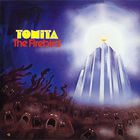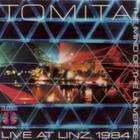Isao Tomita

- Genres:
- Avant-Garde, Classical, Electronic, International, New Age
- Meta styles:
- Avant-Garde Music, Experimental Electronic, Japanese Traditions, Progressive Electronic
Isao Tomita (?? ?, Tomita Isao, born April 22, 1932), often known simply as Tomita, is a Japanese music composer, regarded as one of the pioneers of electronic music and space music, and as one of the most famous producers of analog synthesizer arrangements. In addition to creating note-by-note realizations, Tomita made extensive use of the sound design capabilities of his instrument, using synthesizers to create new artificial sounds to accompany and enhance his electronic realizations of acoustic instruments.
He also made effective use of analog music sequencers and featured futuristic science fiction themes, while laying the foundations for synth-pop music and trance-like rhythms. He also received four Grammy Award nominations for his album Snowflakes are Dancing in 1974.
Tomita bridged the gap between note-by-note classical/electronic LPs like Switched-On Bach and the more futuristic, user-friendly interfaces developed in the 1970s. After creating one of the first personal recording studios with an array of top synthesizer gear in the early '70s, Tomita applied his visions for space-age synthesizer music to his favorite modern composers -- Claude Debussy, Igor Stravinsky, Maurice Ravel -- though his recordings steered a course beyond the academicism of Wendy Carlos and other synthesists. Born in Tokyo in 1932, Tomita grew up in China as well as Japan, studying composition and music theory as well as art history at Keio University. After graduation in 1955, Tomita began composing film, television and theater music. He was awarded frequently during the 1950s and '60s, and became perhaps the most well-known contemporary Japanese composer.
By the early '70s, Isao Tomita was introduced to the seminal work of synthesizer gurus Wendy Carlos and Robert Moog, sparking his own interest in synthesized music. In 1973, he formed the electronic collective Plasma Music with musicians Kinji Kitashoji and Mitsuo Miyamoto, and spent more than a year stocking his home studio with electronics gear (including the Moog III used for Carlos' Switched-On Bach). Tomita's first album, 1974's Snowflakes Are Dancing, electrified the Japanese public and even translated to an American classical audience, where it was nominated for four Grammy awards. Successive albums Pictures at an Exhibition, The Firebird Suite and his masterpiece Holst: The Planets infused the classical-synthesizer fusion craze of the 1970s with genuinely exciting, futuristic music instead of the bland, note-by-note translations favored by less visionary musicians. The Planets re-invoked the connection between synthesizer music and science fiction first broached in the 1956 film Forbidden Planet.
Tomita began incorporating digital synth and early MIDI setups with 1982's Grand Canyon, and completely gutted his studio during the next two years during the transition from analogue to digital with his Casio Cosmo system. Though he recorded more sparingly than in the 1970s, Tomita made frequent appearances at enormous concerts, including his 1984 Austrian show Mind of the Universe before 80,000 people and at the Statue of Liberty centennial celebration two years later. Tomita was also awarded the honorary presidency of the Japan Synthesizer Programmers Association.
In 1965, he composed the theme song and incidental music for Osamu Tezuka's animated TV series Jangaru Taitei (Jungle Emperor), released in the USA as Kimba the White Lion. In 1966 he wrote a tone poem based on this music with an original video animation synchronized to the tone poem released in 1991. Isao Tomita and Kunio Miyauchi also created the music for the tokusatsu SF/espionage/action TV series Mighty Jack, which aired in 1968.
- Sort by

The Tale Of Genji (Ultimate Edition) CD2
- Year:
- 2011
- Tracks:
- 9
- Bitrate:
- 320 kbps

The Tale Of Genji (Ultimate Edition) CD1
- Year:
- 2011
- Tracks:
- 13
- Bitrate:
- 320 kbps

Planets: Ultimate Edition
- Year:
- 2011
- Tracks:
- 7
- Bitrate:
- 320 kbps

The Firebird
- Year:
- 2007
- Tracks:
- 9
- Bitrate:
- 320 kbps

Different Dimensions
- Year:
- 1997
- Tracks:
- 18
- Bitrate:
- 320 kbps

Storm From The East
- Year:
- 1992
- Tracks:
- 15
- Bitrate:
- 320 kbps

Kosmos
- Year:
- 1991
- Tracks:
- 8
- Bitrate:
- 320 kbps

Back To The Earth (Live In New York 1986)
- Year:
- 1988
- Tracks:
- 11
- Bitrate:
- 320 kbps

Back To The Earth (Live In New York)
- Year:
- 1988
- Tracks:
- 11
- Bitrate:
- 199 kbps

Tomita Live at Linz 1984/The Mind of the Universe
- Year:
- 1985
- Tracks:
- 12
- Bitrate:
- 320 kbps
 Prequell
Prequell